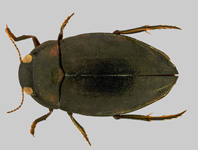Abstract
A new genus Hemiocnus is here erected to accommodate the Mediterranean dendrochirotid sea cucumber Cladodactyla syracusana Grube, currently classified, with some doubt, in the cucumariid genus Pseudocnella. At the same time a new cucumariid species, Hemiocnus rubrobrunneus, is described from some Tunisian material, misidentified as Pseudocnella syracusana (Grube), received from the United States National Museum. The new genus appears most closely related to Pseudocnella than to any other genus within the Colochirinae. Although its body wall ossicles resemble those of Pseudocnella spp. it differs in that the two ventral-most tentacles are reduced and in the presence of rosettes in the tentacles. P. syracusana also cannot be classified in Ocnus because of the presence of multi-layered, fir-cone shaped plates in the body wall, often with one end denticulate; such ossicles are lacking in the type species of the latter genus. The new species, Hemiocnus rubrobrunneus, on the other hand, shows some resemblance to H. syracusanus in its characteristic buttons and incomplete baskets, differing in its softer body wall, lack of fir-cone-shaped plates and in the presence of rosettes and complete baskets in the body wall. There are also some resemblances of the new species to the Mediterranean species of Ocnus viz. O. brunneus, O. planci and O. lacteus, but the soft nature of the body wall, shallow quadrilocular instead of deep trilocular baskets, and the presence of large knobbed plates in the anal region precludes its inclusion in this genus.
References
Cherbonnier, G. (1956) Les echinodermes de Tunisie. Bulletin de l’Institut National des Sciences et Technologie de la Mer Salammbo, 53,1–22.
Forbes, E. (1841) A History of British Starfishes and other Animals of the Class Echinodermata. John van Voorst, London, 167 pp.
Grube, A.E. (1840) Aktinien, Echinodermen un Wurmer des Adriatischen und Mittelmeeres. Konigsberg, pp. 1–92.
http://dx.doi.org/10.5962/bhl.title.23025Koehler, R. (1921) Faune de France. 1 Echinodermes. Federation Francaise Des Cocieties de Sciences Naturelles, pp.140–191
http://dx.doi.org/10.5962/bhl.title.11514.Panning, A. (1949) Versuch einer Neuordnung der Familie Cucumariidae (Holothurioidea, Dendrochirota). Zoologische Jahrbücher Abtheilung für Systematik, Geographie und Biologie der Thiere, 78, 404–470.
Panning, A. (1962) Bermerkungen über die Holothurien–Familie Cucumariidae (Ordnung Dendrochirota) 3 Teil. Die Gattung Pseudocnus (Panning 1949). Mitteilungen aus dem Hamburgischen Zoologischen Museum und Institut, 60,57–80.
Rowe, F.W.E. & Gates, J. (1995) Echinodermata. In: Wells, A. (Ed.), Zoological Catalogue of Australia Vol. 33, Melbourne, CSIRO Australia xiii, 510 pp.
Sars, M. (1857) Bidrag til Kundskaben om Middlehavets Littoral-Fauna. Nyt Magasin fur Naturvidenskapene, 10, 1–99.
Thandar, A.S. (1987) The status of some southern African nominal species of Cucumaria (s.e.) referable to a new genus and their ecological isolation. South African Journal of Zoology, 22 (4), 287–296.
http://dx.doi.org/10.1080/02541858.1987.11448059Théel, H. (1886) Holothuroidea. Part II. Report on the Scientific Results of the of the HMS ‘Challenger’ during the years 1873–1876. Zoology, 4 (34), 1–290.

